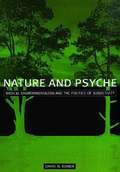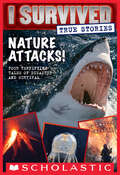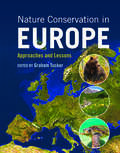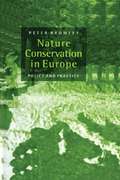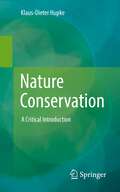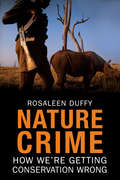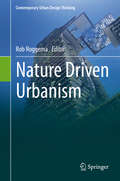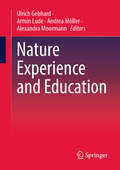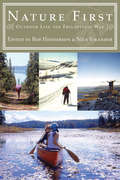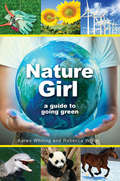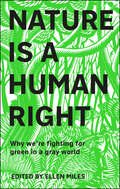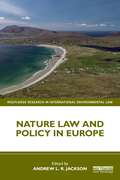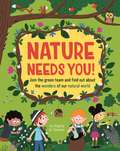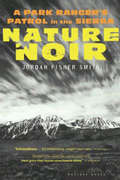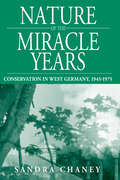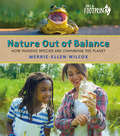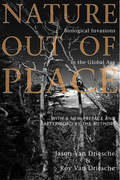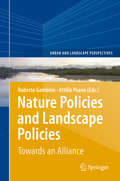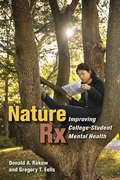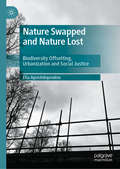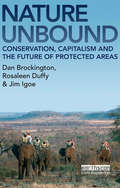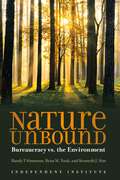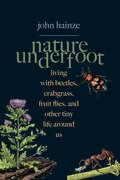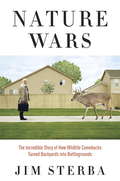- Table View
- List View
Nature And Psyche: Radical Environmentalism And The Politics Of Subjectivity
by David KidnerNature and Psyche argues that psychological and environmental writing and action are all too often colonized by the same assumptions that inhibit ecological and cultural diversity. Industrialized monocultures conceal the character of our alienation from nature and, thus, prevent the emergence of effective solutions. Drawing on a diversity of disciplines, David Kidner illustrates that traditional psychological understanding is often inherently hostile to the natural order, and that the dominant form of selfhood that has emerged in the industrialized world promotes the domestication of nature. In fact, even some of the most radical environmentalists, who simplistically oppose technology, are also trapped within this paradigm. The author demonstrates that a more critical historical and cultural awareness, rooted in nature, can enable a re-integration of nature and psyche.
Nature Attacks! (I Survived True Stories #2)
by Lauren TarshisFrom the author of the New York Times-bestselling I Survived series come four harrowing true stories of survival, featuring real kids in the midst of epic disasters.REAL KIDS. REAL DISASTERS.The author of the New York Times-bestselling I Survived series brings us more harrowing true stories of real kids up against terrible forces of nature. From fourteen-year-old lone survivor of the shark attacks of 1916, to nine-year-old who survived the Peshtigo fire of 1871 (which took place on the very same day in history as the Great Chicago Fire!), here are four unforgettable survivors who managed to beat the odds.Read their incredible stories:The Deadly Shark Attacks of 1916The Great Peshtigo Fire of 1871A Venomous Box Jellyfish AttackThe Eruption of Mount Tambora
Nature Conservation in Europe: Approaches and Lessons
by Graham TuckerEuropean ecosystems and species remain under pressure from intensive agriculture and forestry, fishing, pollution, urban sprawl, invasive species and climate change. This book provides a detailed description and critical analysis of nature conservation responses, achievements and failures, motivated by the concerning state of nature and missed biodiversity targets. It summarises Europe's nature and the impact of human activities, and then gives an overview of relevant international biodiversity treaties and the EU nature conservation policy and legislative framework. The core of the book comprises chapters written by national experts, which cover the UK and twenty-five EU Member States, providing comparative case studies from which valuable lessons are drawn. Covering wide-ranging topics such as biodiversity pressures, legislation and governance, biodiversity strategies, species protection, protected areas, habitat management, and funding, this book is of interest to a wide audience, including academics and professionals involved in nature conservation and related environmental fields.
Nature Conservation in Europe: Policy and Practice
by Peter BromleyThe Rio Summit has pointed to the urgency for the development of an international conservation policy; and the post-Maastricht debates in Europe have highlighted the need for the EU to reassess structural funding in nature conservation, as well as the influences on policy and practice.This book is a 'route map' through the legislative and policy frameworks and explains how conservation works in Europe. It goes through the policies for nature conservation in the European Community and its constituent member states and sets out the mechanisms for delivering this policy.An understanding of the European legislative framework is now vital as its influence on local practice increases. Practitioners in the fields of countryside conservation and general land management will find the book an essential guide to the working of the EU, as well as helping an appreciation of their local role within the wider community objectives. This will, for example allow a better understanding of the grant system which many managers are now using.
Nature Conservation: A Critical Introduction
by Klaus-Dieter HupkeMany things happen in nature reserves that are contradictory at first glance. For example, flower meadows are mown down during maintenance work, even though all the plants growing there are protected. Elsewhere, protected reed beds are burnt down in a fen or the top layer of soil is removed with bulldozers in a dune conservation area. Still other areas are to remain completely untouched by human intervention. The author Klaus-Dieter Hupke shows the different strategies of nature conservation. He also shows that nature conservation is mostly not exactly what the term says in essence: "protection of nature". On the contrary, in Central Europe nature conservation areas are predominantly the relics of old agricultural and thus cultural landscapes. Often, aesthetic aspects of a landscape section are also in the foreground when designating it as a natural monument or nature reserve. Moreover, nature conservation runs the risk of becoming a substitute action and an alibi for a still growing destruction of traditional and near-natural landscape systems in Central Europe as well as globally.The updated second edition now explicitly includes the consequences of climate change for nature conservation and has also incorporated a stronger reference to Austria as well as to the central Alpine region in some places for the relevant readers.
Nature Crime
by Rosaleen DuffyIn this impressively researched, alarming book, Rosaleen Duffy investigates the world of nature conservation, arguing that the West's attitude to endangered wildlife is shallow, self-contradictory, and ultimately very damaging. Analyzing the workings of the black-market wildlife industry, Duffy points out that illegal trading is often the direct result of Western consumer desires, from coltan for cellular phones to exotic meats sold in London street markets. She looks at the role of ecotourism, showing how Western travelers contribute--often unwittingly--to the destruction of natural environments. Most strikingly, she argues that the imperatives of Western-style conservation often result in serious injustice to local people, who are branded as "problems" and subject to severe restrictions on their way of life and even extrajudicial killings.
Nature Driven Urbanism (Contemporary Urban Design Thinking)
by Rob RoggemaThis book discusses the way that a nature-driven approach to urbanism can be applied at each of the urban scales; architectural design, urban design of neighborhoods, city planning and landscape architecture, and at the city and regional scales. At all levels nature-driven approaches to design and planning add to the quality of the built structure and furthermore to the quality of life experienced by people living in these environments. To include nature and greening to built structures is a good starting point and can add much value. The chapter authors have fiducia in giving nature a fundamental role as an integrated network in city design, or to make nature the entrance point of the design process, and base the design on the needs and qualities of nature itself. The highest existence of nature is a permanent ecosystem which endures stressors and circumstances for a prolonged period. In an urban context this is not always possible and temporality is an interesting concept explored when nature is not a permanent feature. The ecological contribution to the environment, and indirect dispersion of species, from a temporary location will, overall add biodiversity to the entire system.
Nature Experience and Education (Contributions from Biology Education Research)
by Ulrich Gebhard Armin Lude Andrea Möller Alexandra MoormannExperiencing nature has positive effects on mental development, health, and well-being, and can be interpreted as an element of a &“good life.&” This book relates this connection to learning and educational settings. Educational processes in biology education are defined not only by the acquisition of relevant subject matter but also about the encounter, confrontation, and transformation of the self. The central assumptions of this book are, firstly, that the latter can be facilitated through nature experiences, and secondly, that this can also positively influence (subject-specific) learning processes.
Nature First: Outdoor Life the Friluftsliv Way
by Bob Henderson Nils VikanderNature First combines the Scandinavian approach to creating a relationship with nature (known as friluftsliv) with efforts by Canadian and international educators to adapt this wisdom and apply it to everyday life experiences in the open air. The word friluftsliv literally refers to "free-air life" or outdoor life. A word saturated with values, the concept can permeate deeply and playfully into ones cultural being and personal psyche, thus influencing the way one perceives and interacts with nature on a daily basis. For centuries, the North American approach has been one of domination and bringing nature under control, in many cases abusing our natural environment in the process. The friluftsliv way of being on "talking terms with nature," developing an "insider’s" relationship with nature, offers the rich potential of allowing us as cohabiters on the Earth to recreate, rejuvenate and restore the balance among all living things. Nature First is the first English-language anthology to bring together the perspectives and experiences of North American, Norwegian, Swedish and other international outdoor writers, all friluftsliv thinkers and doers. Here, the thirty contributors’ use of history, sociology, psychology, philosophy and outdoor education writings blend to provide an understanding of how friluftsliv applies to everyday life. The book presents an alternative to much of the personal growth/adventure-based literature that tends to dominate our current approach to the outdoor activity. Folklore, heritage, adventure travel, crafts, place-based education and the daily outings of families all have a role to play in promoting an understanding of both the ordinary and the mystical importance of this Nordic tradition. Dedicated to parents, travel guides, educators and generally to participants in the outdoors, Nature First provides a compellingly fresh approach to life in the out-of-doors.
Nature Girl: A Guide to Caring for God's Creation
by Karen Whiting Rebecca WhiteLove God, Love the Planet As you become an expert in all things green, Nature Girl offers fun ways to care for God’s creations while enjoying the wonders of nature! With activities, recipes, science experiments, and much more, you can discover how to create recycled jewelry, plan a spa day with friends, make your own earth-friendly skin care products, or team up to clean a park or a neighbor’s yard. Each chapter covers different topics, like water, air, energy, and recycling, and includes crafts, Scripture, games, quizzes, interviews with experts, and quotes from real girls like you. From the itty-bitty flowers at your feet to the air high above your head, discover how you can make a difference for our planet.
Nature Inside: A biophilic design guide
by William D. Browning Catherine O. RyanWritten by a leading proponent of biophilic design, this is the only practical guide to biophilic design principles for interior designers. Describing the key benefits, principles and processes of biophilic design, Nature Inside illustrates the implementation of biophilic design in interior design practice, across a range of international case studies – at different scales, and different typologies. Starting with the principles of biophilic design, and the principles and processes in practice, the book then showcases a variety of interior spaces – residential, retail, workplace, hospitality, education, healthcare and manufacturing. The final chapter looks ‘outside the walls’, giving a case study at the campus and city scale. With practical guidance and real-world solutions that can be directly-applied in day-to-day practice, this is a must-have for designers interested in applying biophilic principles.
Nature Is A Human Right: Why We're Fighting for Green in a Gray World
by Ellen MilesFighting for a green world — a collection of essays and writing for building an equal, healthier society. Access to the natural world is a human right. This inspiring book captures why contact with nature is essential for our mental, social and physical well-being — and how we can rethink urban development to create green city spaces and a return to nature.Find an inspiring collection of original writings from world-leading &“green&” voices and discover: • Benefits and issues surrounding our access to nature • Discussions on social and environmental justice • Why we need nature around us, how we&’re being deprived of nature and what we can all do to change environmental and social issues • Edited by the founder of the environmental justice campaign Nature is a Human Right, Ellen Miles Concrete outweighs every tree, bush, and shrub on Earth. Nature deprivation is a fast-growing epidemic, harming the health and happiness of hundreds of millions of people worldwide — especially vulnerable and marginalized groups. Nature is a Human Right, founded by Ellen Miles in 2020, is working to make access to green space a recognized right for all, not a privilege.This book brings together a collection of engaging, accessible essays, interviews and exercises, from expert ambassadors and supporters (including authors, artists, scientists, human rights experts, television presenters, TED speakers, and climate activists). Each contributor offers a new perspective on why contact with nature should be a protected human right. Enlightening and sometimes uncomfortable, this collection of writing and ideas illuminate the work that needs to be done to make our global future happier.
Nature Law and Policy in Europe (Routledge Research in International Environmental Law)
by Andrew L. R. JacksonThis volume considers current and future challenges for nature law and policy in Europe. Following the Fitness Check evaluation of the Birds and Habitats Directives, in 2017 the EU adopted an Action Plan for nature, people and the economy to rapidly improve the Directives’ implementation and accelerate progress towards the EU's biodiversity targets for 2020. More recently, the EU has adopted a Biodiversity Strategy for 2030 and proposed an EU Nature Restoration Law. This book makes a timely contribution by examining the current state of play in light of recent and historical developments, as well as the post-2020 nature law and policy landscape. While evidence suggests that Natura 2000 and the Habitats and Birds Directives have delivered conservation benefits for wildlife in Europe, biodiversity loss continues apace. The book reviews the requirements for an effective international nature conservation system, with reference to the Birds and Habitats Directives. It examines regulatory regimes, current legal issues in the fields of site protection and species protection, the protection of areas outside Natura 2000, recent developments in the EU and the UK, including the implications of Brexit, agriculture and nature conservation, litigation, science and access to justice. Written by leading experts in the field, from a range of stakeholder groups, the volume draws on diverse experiences as well as providing interdisciplinary perspectives. This volume will be essential reading for students, scholars, practitioners, NGOs and policy-makers interested in European environmental policy and law, including for example lawyers, ecologists, environmental scientists, political scientists, natural resource managers, planners and civil servants.
Nature Needs You!: Join the Green Team and find out about the wonders of our natural world
by Liz GogerlyFour friends, Anjali, Lulu, Mason and Noah, discover an injured fox in the garden and need to take it to an animal rescue centre. There, they begin a year of discovery learning about the amazing animals, plants and places that make up our natural world.As the year goes on the children talk to lots of different people, from park rangers and environmentalists, to teachers and grandparents. They learn lots of things about the natural world, from biodiversity, food chains and climate change to pollination, plastic pollution and ecosystems.Throughout there are 'Take Action' advice panels, which give examples of small ways that people can get involved to help protect nature.Get Busy activity suggestions encourage children to be actively engaged with nature, by birdwatching or planting wild flowers.There are also full-page, step-by-step activities for how to make a bug hotel and a bird feeder.By the end of the book, readers will have a better understanding of the importance of nature, humans impact on nature and what can be done to help protect itLook out for the other titles in this series: Go Green, Wild Weather and Save our Seas.
Nature Noir: A Park Ranger's Patrol in the Sierra
by Jordan Fisher Smith&“A nature book unlike any other…peppered with gritty, anti-romantic, all-too-real tales of cops &’n&’ bad guys in the great outdoors.&”—The San Diego Union-Tribune Jordan Fisher Smith&’s startling account of fourteen years as a park ranger thoroughly dispels our idealized visions of life in the great outdoors. Instead of scout troops and placid birdwatchers, Smith's beat—a stretch of land that has been officially condemned to be flooded—brings him into contact with drug users tweaked out to the point of violence, obsessed miners, and other dangerous creatures. In unflinchingly honest prose, he both portrays the breathtaking natural world around him and reveals the unexpectedly dark underbelly of patrolling and protecting public lands. &“Gloriously unlike anything I&’ve ever read before…gives entree into a strange, dark, and mesmerizing outdoor world that's absolutely unforgettable.&”—The Boston Globe &“By turns funny, poignant and surprising…an intimate memoir of the career of a state-park ranger. Not just any ranger, but one with a wicked pen, patrolling a doomed landscape.&”—Seattle Times/Post-Intelligencer &“Compelling…refreshingly unsentimental.&”—Barry Lopez, author of Arctic Dreams &“Smith offers a fresh perspective on our threatened environment…Nature Noir reflects the spirit of an era as did Desert Solitaire.&”—Charlotte Observer
Nature Of The Miracle Years: Conservation in West Germany, 1945-1975 (Studies in German History #8)
by Sandra ChaneyAfter 1945, those responsible for conservation in Germany resumed their work with a relatively high degree of continuity as far as laws and personnel were concerned. Yet conservationists soon found they had little choice but to modernize their views and practices in the challenging postwar context. Forced to change by necessity, those involved in state-sponsored conservation institutionalized and professionalized their efforts, while several private groups became more confrontational in their message and tactics. Through their steady and often conservative presence within the mainstream of West German society, conservationists ensured that by 1970 the map of the country was dotted with hundreds of reserves, dozens of nature parks, and one national park. In doing so, they assured themselves a strong position to participate in, rather than be excluded from, the left-leaning environmental movement of the 1970s.
Nature Out of Balance: How Invasive Species Are Changing the Planet (Orca Footprints #19)
by Merrie-Ellen WilcoxInvasive species threaten local ecosystems and the planet’s biodiversity, but are they all as bad as we think they are? Plants, animals, insects and fish are moving in. In Nature Out of Balance:How Invasive Species Are Changing the Planet author Merrie-Ellen Wilcox profiles all-star invasive species around the world, starting in her own neighbourhood, and warns that humans are the most invasive species of all. We find out how and why species become invasive, what we can do to stop their spread and whether it’s time to think differently about invasive species that are here to stay.
Nature Out of Place: Biological Invasions In The Global Age
by Jason Van Driesche Roy Van DriescheThough the forests are still green and the lakes full of water, an unending stream of invasions is changing many ecosystems around the world from productive, tightly integrated webs of native species to loose assemblages of stressed native species and aggressive invaders. The earth is becoming what author David Quammen has called a "planet of weeds." Nature Out of Place brings this devastating but overlooked crisis to the forefront of public consciousness by offering a fascinating exploration of its causes and consequences, along with a thoughtful and practical consideration of what can be done about it. The father and son team of Jason and Roy Van Driesche offer a unique combination of narratives that highlight specific locations and problems along with comprehensive explanations of the underlying scientific and policy issues.Chapters examine Hawaii, where introduced feral pigs are destroying the islands' native forests; zebra mussel invasion in the rivers of Ohio; the decades-long effort to eradicate an invasive weed on the Great Plains; and a story about the restoration of both ecological and human history in an urban natural area. In-depth background chapters explain topics ranging from how ecosystems become diverse, to the characteristics of effective invaders, to procedures and policies that can help prevent future invasions. The book ends with a number of specific suggestions for ways that individuals can help reduce the impacts of invasive species, and offers resources for further information.By bringing the problem of invasive species to life for readers at all levels, Nature Out of Place will play an essential role in the vital effort to raise public awareness of this ongoing ecological crisis.
Nature Policies and Landscape Policies
by Attilia Peano Roberto GambinoThe book focuses on the relationship between nature conservation policies and landscape policies. This is a relevant subject due to the current need of reviving nature conservation policies, which are today affected by a general effectiveness deficiency. To this end, landscape policies can play a crucial role, bridging nature and culture, fostering more integrated approaches to nature conservation and stimulating the active participation of local communities. The book gathers reflections, researches and experiences developed on an international level on this subject by experts coming from different international contexts (Europe, U. S. A. ), various disciplinary backgrounds (geographers, planners, biologists, historians, jurists, economists, etc. ) and several institutional bodies (Universities, administrative bodies, international organizations such as IUCN, EUROPARC Federation, UNESCO, etc. ). The overall reflections gathered in the book - which is divided in three main sections: regulations and institutional frameworks, policies, actions and tools - combine to suggest innovative visions about the relationships between nature policies and landscape policies.
Nature Rx: Improving College-Student Mental Health
by Donald A. Rakow Gregory T. EellsThe Nature Rx movement is changing campus life. Offering alternative ways to deal with the stress that students are under, these programs are redefining how to provide students with the best possible environment in which to be healthy, productive members of the academic community. In Nature Rx, Donald A. Rakow and Gregory T. Eells summarize the value of nature prescription programs designed to encourage college students to spend time in nature and to develop a greater appreciation for the natural world. Because these programs are relatively new, there are many lessons for practitioners to learn; but clinical studies demonstrate that students who regularly spend time in nature have reduced stress and anxiety levels and improved mood and outlook.In addition to the latest research, the authors present a step-by-step formula for constructing, sustaining, and evaluating Nature Rx programs, and they profile four such programs at American colleges. The practical guidance in Nature Rx alongside the authors' vigorous argument for the benefits of these programs for both students and institutions places Rakow and Eells at the forefront of this burgeoning movement.
Nature Swapped and Nature Lost: Biodiversity Offsetting, Urbanization and Social Justice
by Elia ApostolopoulouThis book unravels the profound implications of biodiversity offsetting for nature-society relationships and its links to environmental and social inequality. Drawing on people’s resistance against its implementation in several urban and rural places across England, it explores how the production of equivalent natures, the core promise of offsetting, reframes socionatures both discursively and materially transforming places and livelihoods.The book draws on theories and concepts from human geography, political ecology, and Marxist political economy, and aims to shift the trajectory of the current literature on the interplay between offsetting, urbanization and the neoliberal reconstruction of conservation and planning policies in the era following the 2008 financial crash. By shedding light on offsetting’s contested geographies, it offers a fundamental retheorization of offsetting capable of demonstrating how offsetting, and more broadly revanchist neoliberal policies, are increasingly used to support capitalist urban growth producing socially, environmentally and geographically uneven outcomes. Nature Swapped and Nature Lost brings forward an understanding of environmental politics as class politics and sees environmental justice as inextricably linked to social justice. It effectively challenges the dystopia of offsetting’s ahistorical and asocial non-places and proposes a radically different pathway for gaining social control over the production of nature by linking struggles for the right to the city with struggles for the right to nature for all.
Nature Unbound: "Conservation, Capitalism and the Future of Protected Areas"
by Rosaleen Duffy Dan Brockington Jim IgoeThis groundbreaking volume is the first comprehensive, critical examination of the rise of protected areas and their current social and economic position in our world. It examines the social impacts of protected areas, the conflicts that surround them, the alternatives to them and the conceptual categories they impose. The book explores key debates on devolution, participation and democracy; the role and uniqueness of indigenous peoples and other local communities; institutions and resource management; hegemony, myth and symbolic power in conservation success stories; tourism, poverty and conservation; and the transformation of social and material relations which community conservation entails. For conservation practitioners and protected area professionals not accustomed to criticisms of their work, or students new to this complex field, the book will provide an understanding of the history and current state of affairs in the rise of protected areas. It introduces the concepts, theories and writers on which critiques of conservation have been built, and provides the means by which practitioners can understand problems with which they are wrestling. For advanced researchers the book will present a critique of the current debates on protected areas and provide a host of jumping off points for an array of research avenues
Nature Unbound: Bureaucracy vs. the Environment
by Ryan M. Yonk Randy T Simmons Kenneth J. SimWhat if what we think we know about ecology and environmental policy is just wrong? What if environmental laws often make things worse? What if the very idea of nature has been hijacked by politics? What if wilderness is something we create in our minds, as opposed to being an actual description of nature?In 1934, former U.S. Forest Service offcial Aldo Leopold, a godfather to the modern environmental movement, wrote that &“restrictive laws&” had &“largely failed&” in their mission to conserve America&’s forests, rivers, and other natural resources. Less than forty years later, however, as various events pushed environmental concerns into the public spotlight, lawmakers from both parties championed legislation far more sweeping and restrictive than any Leopold had witnessed. How well did these &“restrictive laws&” work to right environmental wrongs? Why did so many miss the mark? And how should we go about improving our policies? In Nature Unbound, authors Randy Simmons, Ryan M. Yonk, and Kenneth J. Sim offer a devastating critique of federal environmental policy by scrutinizing it through the lenses of biological ecology and political ecology. This powerful framework, they show, reveals that environmental policy has been guided since the late 1960s by demonstrably false assumptions responsible for a host of ineffective or wasteful, command-and-control policies—on air pollution, water pollution, endangered species, wilderness, renewable energy, and more. The mistakes have also empowered political entrepreneurship in ways that have encroached on property rights, burdened the general public, and degraded the civic landscape. More than a critique of false assumptions and flawed policies, Nature Unbound offers bold principles to help us rethink environmental objectives, align incentives with goals, and af?rm the notion that human beings are an integral part of the natural order and merit no less consideration than Earth&’s other treasures. Ultimately, nothing less can succeed in our efforts to restore natural resources and revitalize our social and political ecosystem.
Nature Underfoot: Living with Beetles, Crabgrass, Fruit Flies, and Other Tiny Life Around Us
by John HainzeAn informed and heartfelt tribute to commonly unappreciated plants, insects, and other tiny creatures that reconsiders humanity&’s relationship to nature Fruit flies, silverfish, dandelions, and crabgrass are the bane of many people and the target of numerous chemical and physical eradication efforts. In this compelling reassessment of the relationship between humans and the natural world, John Hainze—an entomologist and former pesticide developer—considers the fascinating and bizarre history of how these so-called invasive or unwanted pests and weeds have coevolved with humanity and highlights the benefits of a greater respect and moral consideration toward these organisms. With deep insight into the lives of the underappreciated and often reviled creatures that surround us, Hainze&’s accessible and engaging natural history draws on ethics, religion, and philosophy as he passionately argues that creepy crawlies and unwanted plants deserve both empathy and accommodation as partners dwelling with us on earth.
Nature Wars
by Jim SterbaThis may be hard to believe but it is very likely that more people live in closer proximity to more wild animals, birds and trees in the eastern United States today than anywhere on the planet at any time in history. For nature lovers, this should be wonderful news -- unless, perhaps, you are one of more than 4,000 drivers who will hit a deer today, your child's soccer field is carpeted with goose droppings, coyotes are killing your pets, the neighbor's cat has turned your bird feeder into a fast-food outlet, wild turkeys have eaten your newly-planted seed corn, beavers have flooded your driveway, or bears are looting your garbage cans. For 400 years, explorers, traders, and settlers plundered North American wildlife and forests in an escalating rampage that culminated in the late 19th century's "era of extermination." By 1900, populations of many wild animals and birds had been reduced to isolated remnants or threatened with extinction, and worry mounted that we were running out of trees. Then, in the 20th century, an incredible turnaround took place. Conservationists outlawed commercial hunting, created wildlife sanctuaries, transplanted isolated species to restored habitats and imposed regulations on hunters and trappers. Over decades, they slowly nursed many wild populations back to health. But after the Second World War something happened that conservationists hadn't foreseen: sprawl. People moved first into suburbs on urban edges, and then kept moving out across a landscape once occupied by family farms. By 2000, a majority of Americans lived in neither cities nor country but in that vast in-between. Much of sprawl has plenty of trees and its human residents offer up more and better amenities than many wild creatures can find in the wild: plenty of food, water, hiding places, and protection from predators with guns. The result is a mix of people and wildlife that should be an animal-lover's dream-come-true but often turns into a sprawl-dweller's nightmare.Nature Wars offers an eye-opening look at how Americans lost touch with the natural landscape, spending 90 percent of their time indoors where nature arrives via television, films and digital screens in which wild creatures often behave like people or cuddly pets. All the while our well-meaning efforts to protect animals allowed wild populations to burgeon out of control, causing damage costing billions, degrading ecosystems, and touching off disputes that polarized communities, setting neighbor against neighbor. Deeply researched, eloquently written, counterintuitive and often humorous Nature Wars will be the definitive book on how we created this unintended mess. From the Hardcover edition.
